3 min read
Bon Voyage to the Ordinary: Top Ecommerce Trends for Travel Brands in 2024
The travel industry is taking flight in the digital realm. As wanderlust reigns supreme, travel brands need to equip themselves with...
3 min read
.jpg) Honcho
:
Feb 10, 2021 5:16:22 AM
Honcho
:
Feb 10, 2021 5:16:22 AM
This post is the first of a series on SLLAM (Subject, Lede, Links, Angles, Methodology) the outreach strategy used by Honchō’s Digital PR and Outreach team. Today, we’re focusing on Subject.
I recently read an article on the BBC that described life saving surgery for a previously fully blind man, with a focus on his comeback from a tragic injury and the technology that recovered some of his sight.
As well as the fascinating story, what struck me was how good the headline was in providing immediate context and drawing the reader in.
You might imagine it read:
But, the BBC went with:
The addition of “his wife” to this headline adds more than just two words. It adds emotion to the story; it adds context. It works expertly as a lead in to generate that first click, and tells us that we will be told a story that goes beyond just the fascinating technology that allows people who were once blind to see. It’s a love story, told through tech.
This headline writing is what we need to aim for with subject lines for outreach. We are selling in the story to the journalists at the first point of contact. And, much like their headlines are designed to get readers to click on the article, ours are designed to get the journalist to open the email.
Here are a few tips for writing subject lines that will get opens and write-ups from journalists:
Anyone can get an email open if the subject line is too good to be true. Think about it from a reader’s perspective. We know first-hand the disappointment when a clickbait headline takes it too far and the article itself is left wanting.
A good way to see example misleading headlines? Stop Clickbait. Yes, it highlights some of the more extreme ends of the scale, but it also has a lot of examples that would work for outreach, as long as your emails justify it

In the above example, the offensive term was “Fireman”, not “Firefighter”.
Although it may be rampant for journalists to get clicks, for us at the pitch stage: don’t oversell a banal story with an inaccurate subject line.
The best way to tell if you’ve done this? When tracking open rates with a tool like Buzzstream, keep an eye on whether you’re getting a high amount of opens but not many repeat viewings. This could mean that your story isn’t living up to the headline’s expectations.
The fastest and easiest way to personalise your headline for the publication you’re sending to is to look at how they write headlines in the first place. This can change depending on vertical and publication, but there are some steadfast truisms that you can follow:
It’s quite well known that UK Tabloids like the phrases REVEALED, and ALSO like to CAPITALISE random words THROUGHOUT.

If you’re not sure there’s a pattern, try a site: search on keywords to see if there’s something you can glean. For example, a site search for “the most”; reveals this car site uses that pattern a lot in headlines. As such, it’s worth tweaking emails to them to follow this.

Here’s a great list of search operators you can use for outreach.
Finally, you don’t always have to write the subject line verbatim to how you want it to turn out. Including signifiers like (Data) or (Gallery) are effective ways to communicate the type of story you’re pitching in alongside an interesting subject line.
Surprising numbers and outrageous figures are a fantastic thing to put into headlines. Look at the below examples and see which one stands out the least.



The least interesting is the one without the numbers. Our eyes are drawn to £41.7m and £14m MORE. If you were pitching this story into a journalist, using these numbers would be more effective to stand out in a journalist’s busy inbox.
Secondly, if you’re relying on numbers from a survey, look a bit harder for the surprising numbers. You might not get them straight away, but it can be easy to forget to look at the inverse of your answers. An example headline from a few years ago:

This headline can also read: 90% of British people know exactly where Ireland is on a map. But, that obviously wouldn’t be as interesting. Also, don’t forget to play around with the wording, for example, “more than half”; is far more effective than “51%”.
Finally, an easy mistake to make. Tweak your numbers and vocab for the audience you’re pitching. Leaving a story in pounds and not changing it to dollars for an American journalist is an easy way to not get opens. The closer you can write to the language of the journalist, the easier it is for them to see your pitch featuring on their site.
We only have so much control on the headlines that end up in the coverage. The aim of this isn’t to try to secure the best headline for a client, it’s to do some of the work for a journalist. This could be not wasting their time with false promises, allowing them to see the story in their house style, and showing them the standout numbers and surprises without having to dig for it.
The more work you do at the pitch stage, the less work they have to do at the write-up.
Do you have a Digital PR project that we can help with? Get in touch using the form below and find out how our bespoke strategies can help reach your online goals.

3 min read
The travel industry is taking flight in the digital realm. As wanderlust reigns supreme, travel brands need to equip themselves with...

2 min read
The fashion scene is undergoing a digital makeover. With consumer habits constantly shifting, fashion brands need to adapt and embrace innovative...

2 min read
The home and garden landscape is blooming in digital. As consumer preferences evolve, home and garden businesses need to cultivate innovative...